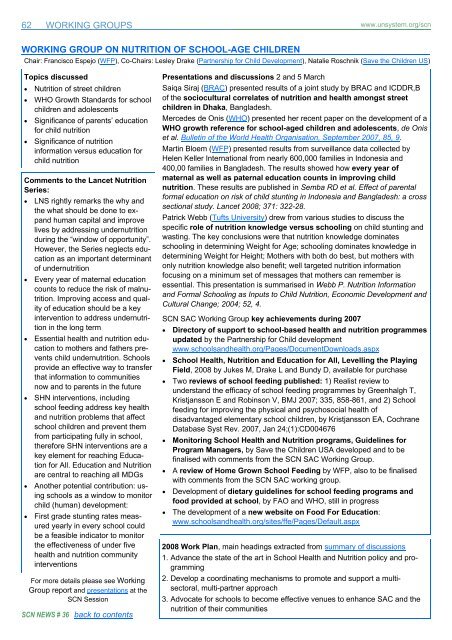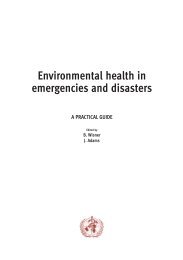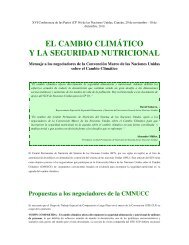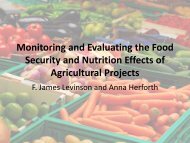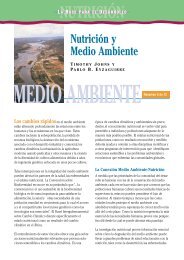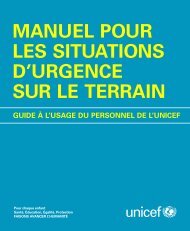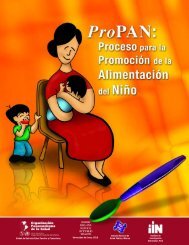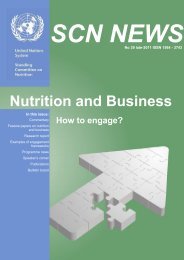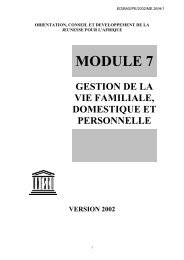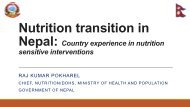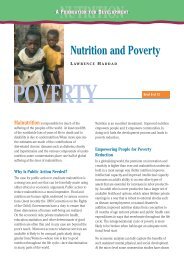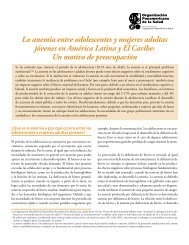SCN News No 36 - UNSCN
SCN News No 36 - UNSCN
SCN News No 36 - UNSCN
Create successful ePaper yourself
Turn your PDF publications into a flip-book with our unique Google optimized e-Paper software.
62<br />
WORKING GROUPS<br />
www.unsystem.org/scn<br />
WORKING GROUP ON NUTRITION OF SCHOOL-AGE CHILDREN<br />
Chair: Francisco Espejo (WFP), Co-Chairs: Lesley Drake (Partnership for Child Development), Natalie Roschnik (Save the Children US)<br />
Topics discussed<br />
• Nutrition of street children<br />
• WHO Growth Standards for school<br />
children and adolescents<br />
• Significance of parents’ education<br />
for child nutrition<br />
• Significance of nutrition<br />
information versus education for<br />
child nutrition<br />
Comments to the Lancet Nutrition<br />
Series:<br />
• LNS rightly remarks the why and<br />
the what should be done to expand<br />
human capital and improve<br />
lives by addressing undernutrition<br />
during the “window of opportunity”.<br />
However, the Series neglects education<br />
as an important determinant<br />
of undernutrition<br />
• Every year of maternal education<br />
counts to reduce the risk of malnutrition.<br />
Improving access and quality<br />
of education should be a key<br />
intervention to address undernutrition<br />
in the long term<br />
• Essential health and nutrition education<br />
to mothers and fathers prevents<br />
child undernutrition. Schools<br />
provide an effective way to transfer<br />
that information to communities<br />
now and to parents in the future<br />
• SHN interventions, including<br />
school feeding address key health<br />
and nutrition problems that affect<br />
school children and prevent them<br />
from participating fully in school,<br />
therefore SHN interventions are a<br />
key element for reaching Education<br />
for All. Education and Nutrition<br />
are central to reaching all MDGs<br />
• Another potential contribution: using<br />
schools as a window to monitor<br />
child (human) development:<br />
• First grade stunting rates measured<br />
yearly in every school could<br />
be a feasible indicator to monitor<br />
the effectiveness of under five<br />
health and nutrition community<br />
interventions<br />
For more details please see Working<br />
Group report and presentations at the<br />
<strong>SCN</strong> Session<br />
<strong>SCN</strong> NEWS # <strong>36</strong> back to contents<br />
Presentations and discussions 2 and 5 March<br />
Saiqa Siraj (BRAC) presented results of a joint study by BRAC and ICDDR,B<br />
of the sociocultural correlates of nutrition and health amongst street<br />
children in Dhaka, Bangladesh.<br />
Mercedes de Onis (WHO) presented her recent paper on the development of a<br />
WHO growth reference for school-aged children and adolescents, de Onis<br />
et al. Bulletin of the World Health Organisation, September 2007, 85, 9.<br />
Martin Bloem (WFP) presented results from surveillance data collected by<br />
Helen Keller International from nearly 600,000 families in Indonesia and<br />
400,00 families in Bangladesh. The results showed how every year of<br />
maternal as well as paternal education counts in improving child<br />
nutrition. These results are published in Semba RD et al. Effect of parental<br />
formal education on risk of child stunting in Indonesia and Bangladesh: a cross<br />
sectional study. Lancet 2008; 371: 322-28.<br />
Patrick Webb (Tufts University) drew from various studies to discuss the<br />
specific role of nutrition knowledge versus schooling on child stunting and<br />
wasting. The key conclusions were that nutrition knowledge dominates<br />
schooling in determining Weight for Age; schooling dominates knowledge in<br />
determining Weight for Height; Mothers with both do best, but mothers with<br />
only nutrition knowledge also benefit; well targeted nutrition information<br />
focusing on a minimum set of messages that mothers can remember is<br />
essential. This presentation is summarised in Webb P. Nutrition Information<br />
and Formal Schooling as Inputs to Child Nutrition, Economic Development and<br />
Cultural Change; 2004; 52, 4.<br />
<strong>SCN</strong> SAC Working Group key achievements during 2007<br />
• Directory of support to school-based health and nutrition programmes<br />
updated by the Partnership for Child development<br />
www.schoolsandhealth.org/Pages/DocumentDownloads.aspx<br />
• School Health, Nutrition and Education for All, Levelling the Playing<br />
Field, 2008 by Jukes M, Drake L and Bundy D, available for purchase<br />
• Two reviews of school feeding published: 1) Realist review to<br />
understand the efficacy of school feeding programmes by Greenhalgh T,<br />
Kristjansson E and Robinson V, BMJ 2007; 335, 858-861, and 2) School<br />
feeding for improving the physical and psychosocial health of<br />
disadvantaged elementary school children, by Kristjansson EA, Cochrane<br />
Database Syst Rev. 2007, Jan 24;(1):CD004676<br />
• Monitoring School Health and Nutrition programs, Guidelines for<br />
Program Managers, by Save the Children USA developed and to be<br />
finalised with comments from the <strong>SCN</strong> SAC Working Group.<br />
• A review of Home Grown School Feeding by WFP, also to be finalised<br />
with comments from the <strong>SCN</strong> SAC working group.<br />
• Development of dietary guidelines for school feeding programs and<br />
food provided at school, by FAO and WHO, still in progress<br />
• The development of a new website on Food For Education:<br />
www.schoolsandhealth.org/sites/ffe/Pages/Default.aspx<br />
2008 Work Plan, main headings extracted from summary of discussions<br />
1. Advance the state of the art in School Health and Nutrition policy and programming<br />
2. Develop a coordinating mechanisms to promote and support a multisectoral,<br />
multi-partner approach<br />
3. Advocate for schools to become effective venues to enhance SAC and the<br />
nutrition of their communities


